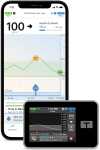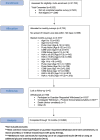Real-World Use of Control-IQ Technology Is Associated with a Lower Rate of Severe Hypoglycemia and Diabetic Ketoacidosis Than Historical Data: Results of the Control-IQ Observational (CLIO) Prospective Study
- PMID: 37782904
- PMCID: PMC10794820
- DOI: 10.1089/dia.2023.0341
Real-World Use of Control-IQ Technology Is Associated with a Lower Rate of Severe Hypoglycemia and Diabetic Ketoacidosis Than Historical Data: Results of the Control-IQ Observational (CLIO) Prospective Study
Abstract
Objective: Severe hypoglycemia (SH) and diabetic ketoacidosis (DKA) remain significant risks with intensive insulin therapy. While these adverse event (AE) rates are generally very low in advanced hybrid closed-loop (AHCL) clinical studies, prospectively collected real-world AE rates are lacking. Research Design and Methods: The Control-IQ Observational (CLIO) study was a single-arm, prospective, longitudinal, postmarket surveillance study of individuals with type 1 diabetes (T1D) age 6 years and older who began the use of t:slim X2 insulin pump with Control-IQ technology in the real-world outpatient setting. AEs were reported monthly over 12 months and were compared to historical data from the T1D Exchange. Patient-reported outcomes were assessed quarterly. All study visits were virtual. Results: Three thousand one hundred fifty-seven participants enrolled from August 2020 through March 2022. Two thousand nine hundred ninety-eight participants completed through 12 months. SH rates were significantly lower than historic rates for children (9.31 vs. 19.31 events/100 patient years, d = 0.29, P < 0.01) and adults (9.77 vs. 29.49 events/100 patient years, d = 0.53, P < 0.01). DKA rates were also significantly lower in both groups. Lower observed rates of AEs occurred independent of baseline hemoglobin A1c or prior insulin delivery method. Time in range 70-180 mg/dL was 70.1% (61.0-78.8) for adults, 61.2% (52.4-70.5) for age 6-13, 60.9% (50.1-71.8) for age 14-17, and 67.3% (57.4-76.9) overall. Reduction in diabetes burden was consistently reported. Conclusions: SH and DKA rates were lower for users of t:slim X2 with Control-IQ technology compared to historical data for both adults and children. Real-world use of this AHCL system proved safe and effective in this virtual study design. The study was registered at clinicaltrials.gov (NCT04503174).
Keywords: Adverse events; Control-IQ technology; Diabetic ketoacidosis; Hypoglycemia; Type 1 diabetes.
Conflict of interest statement
R.G. and E.A.-S. report consulting fees from Tandem Diabetes Care, Inc. L.H.M., M.M., S.H., L.M., and J.E.P. are employees and shareholders of Tandem Diabetes Care, Inc.
Figures


Similar articles
-
Control-IQ Technology Use in Individuals With High Insulin Requirements: Results From the Multicenter Higher-IQ Trial.J Diabetes Sci Technol. 2024 Nov;18(6):1288-1292. doi: 10.1177/19322968241234072. Epub 2024 Mar 5. J Diabetes Sci Technol. 2024. PMID: 38439656 Free PMC article. Clinical Trial.
-
Safety and Glycemic Outcomes During the MiniMedTM Advanced Hybrid Closed-Loop System Pivotal Trial in Children and Adolescents with Type 1 Diabetes.Diabetes Technol Ther. 2023 Nov;25(11):755-764. doi: 10.1089/dia.2023.0255. Epub 2023 Oct 25. Diabetes Technol Ther. 2023. PMID: 37782145 Clinical Trial.
-
Association of Insulin Pump Therapy vs Insulin Injection Therapy With Severe Hypoglycemia, Ketoacidosis, and Glycemic Control Among Children, Adolescents, and Young Adults With Type 1 Diabetes.JAMA. 2017 Oct 10;318(14):1358-1366. doi: 10.1001/jama.2017.13994. JAMA. 2017. PMID: 29049584 Free PMC article.
-
Hypoglycemia and ketoacidosis with insulin pump therapy in children and adolescents.Pediatr Diabetes. 2006 Aug;7 Suppl 4:32-8. doi: 10.1111/j.1399-543X.2006.00169.x. Pediatr Diabetes. 2006. PMID: 16774616 Review.
-
The effect of sodium-glucose cotransporter 2 inhibitors as an adjunct to insulin in patients with type 1 diabetes assessed by continuous glucose monitoring: A systematic review and meta-analysis.J Diabetes Complications. 2023 Dec;37(12):108632. doi: 10.1016/j.jdiacomp.2023.108632. Epub 2023 Oct 21. J Diabetes Complications. 2023. PMID: 37907042
Cited by
-
Artificial Pancreas: The First 20 Years.J Diabetes Sci Technol. 2025 Jul;19(4):875-882. doi: 10.1177/19322968251330920. Epub 2025 Jul 1. J Diabetes Sci Technol. 2025. PMID: 40590462 Free PMC article. No abstract available.
-
Safety and Psychological Outcomes of Tandem t:Slim X2 Insulin Pump with Control-IQ Technology in Children, Adolescents, and Young Adults with Type 1 Diabetes: A Systematic Review.Diabetes Ther. 2024 Oct;15(10):2133-2149. doi: 10.1007/s13300-024-01618-2. Epub 2024 Jul 15. Diabetes Ther. 2024. PMID: 39008237 Free PMC article. Review.
-
Severe Diabetic Ketoacidosis in Children with Type 1 Diabetes: Ongoing Challenges in Care.Children (Basel). 2025 Jan 19;12(1):110. doi: 10.3390/children12010110. Children (Basel). 2025. PMID: 39857941 Free PMC article. Review.
-
Human-machine co-adaptation to automated insulin delivery: a randomised clinical trial using digital twin technology.NPJ Digit Med. 2025 May 6;8(1):253. doi: 10.1038/s41746-025-01679-y. NPJ Digit Med. 2025. PMID: 40329052 Free PMC article.
-
Utility of time in tight range (TITR) in evaluating metabolic control in pediatric and adult patients with type 1 diabetes in treatment with advanced hybrid closed-loop systems.Endocrine. 2024 Nov;86(2):539-545. doi: 10.1007/s12020-024-03881-6. Epub 2024 May 30. Endocrine. 2024. PMID: 38814372 Free PMC article.
References
Publication types
MeSH terms
Substances
Associated data
LinkOut - more resources
Full Text Sources
Medical
Research Materials
